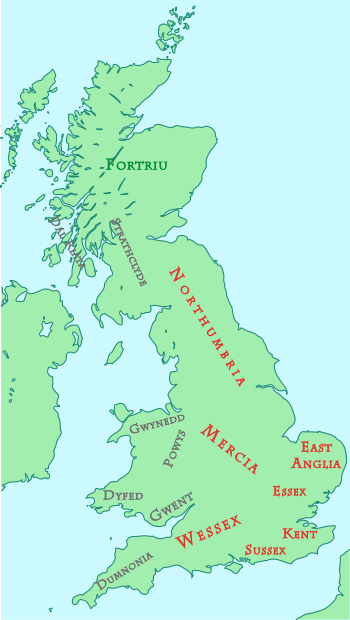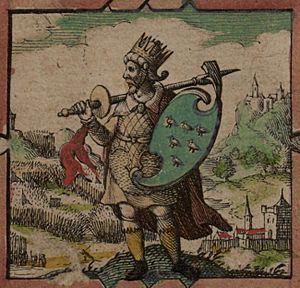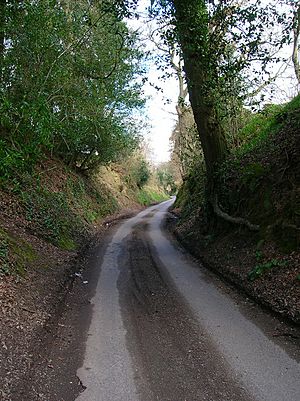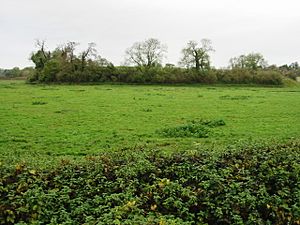Kingdom of Sussex facts for kids
Quick facts for kids
Sussex
|
|||||||||||
|---|---|---|---|---|---|---|---|---|---|---|---|
| c. 477–860 | |||||||||||

Britain around AD 800
|
|||||||||||
| Status | Vassal of Wessex (686–726, 827–860) Vassal of Mercia (771–796) |
||||||||||
| Capital | Chichester Selsey (seat of South Saxon bishopric) |
||||||||||
| Common languages | Old English (Ænglisc) | ||||||||||
| Government | Monarchy | ||||||||||
| Monarchs (see full list) | |||||||||||
|
• 477–491 or later
|
Ælle | ||||||||||
| Æðelwealh | |||||||||||
| Legislature | Witenagemot | ||||||||||
| Historical era | Heptarchy | ||||||||||
|
• Established
|
c. 477 | ||||||||||
|
• Subject to Wessex
|
c. 686 to 726 | ||||||||||
|
• Subject to Mercia
|
771 to c. 796 | ||||||||||
|
• Subject to Wessex
|
From c. 827 | ||||||||||
|
• Full integration into crown of Wessex
|
860 | ||||||||||
| Population | |||||||||||
|
• 450
|
25000 | ||||||||||
|
• 1100
|
35000 | ||||||||||
| Currency | Sceat | ||||||||||
|
|||||||||||
| Today part of | ∟ South East England |
||||||||||
The Kingdom of the South Saxons, today referred to as the Kingdom of Sussex was one of the seven traditional kingdoms of the Heptarchy of Anglo-Saxon England. On the south coast of the island of Great Britain, it was originally a sixth century Saxon colony and later an independent kingdom. The South Saxons were ruled by the kings of Sussex until the country was annexed by Wessex, probably in 827, in the aftermath of the Battle of Ellandun.
At the end of the 4th century there was a decline in the birth rate across Roman Britain; this population decrease would have been made worse by the transfer to Continental Europe of three large armies, recruited in Britain in the last 30 years of Roman rule, as well as plague and barbarian attack.
The earliest recorded Viking raid on Sussex took place in 895 and it was particularly difficult for a scattered farming community to meet these sudden attacks. In 895 the population of Chichester killed many hundreds of Danes who plundered the area. Eadulf, a Saxon noble, was appointed to organise the defence of Sussex but died from the plague before much could be done.
The population of Britain as a whole is likely to have declined sharply around the 4th century from around 2–4 million in AD 200 to less than 1 million in AD 300. There would have been a similarly sharp decline in the population of Sussex during this period. Sussex's population around 450 is estimated to have been no more than about 25,000, rising gradually to around 35,000 by 1100. At the time of the Domesday Book in 1086, Sussex had some of the highest population densities in England.
There is significant evidence for Frankish cultural influence on the kingdom of Sussex as well as the neighbouring kingdom of Kent; occasional references in Continental works suggest that Frankish kings may at one point have thought of the people of Sussex and other south eastern kingdoms as their political dependants.
There are clear cultural differences between how wealth and status were expressed in South Saxon society compared with Anglo Saxon kingdoms to the north. In the kingdom of Sussex and the neighbouring kingdom of Kent the range of ornamented dress, accessories and metalwork is significantly more plain and limited that in kingdoms to the north.
However alternative status symbols were used fully in Sussex by those with higher status. Archaeological evidence shows that luxury food items were consumed in Sussex and luxurious architectural displays were constructed, such as a tower excavated at Bishopstone.
From the beginning of the 6th century, Merovingian artefacts were present in Sussex, as they were in Kent and on the Isle of Wight, which is thought to reflect cross-Channel exchanges between Saxon Sussex and Merovingian Gaul. Cemeteries show continuous contacts with Gaul from the first half of the 5th century until the early 7th century.
Images for kids
-
Harold Godwinson, the future king of England, shown on the Bayeux Tapestry riding with his knights to Bosham from where he set sail in 1064.
See also
 In Spanish: Reino de Sussex para niños
In Spanish: Reino de Sussex para niños






